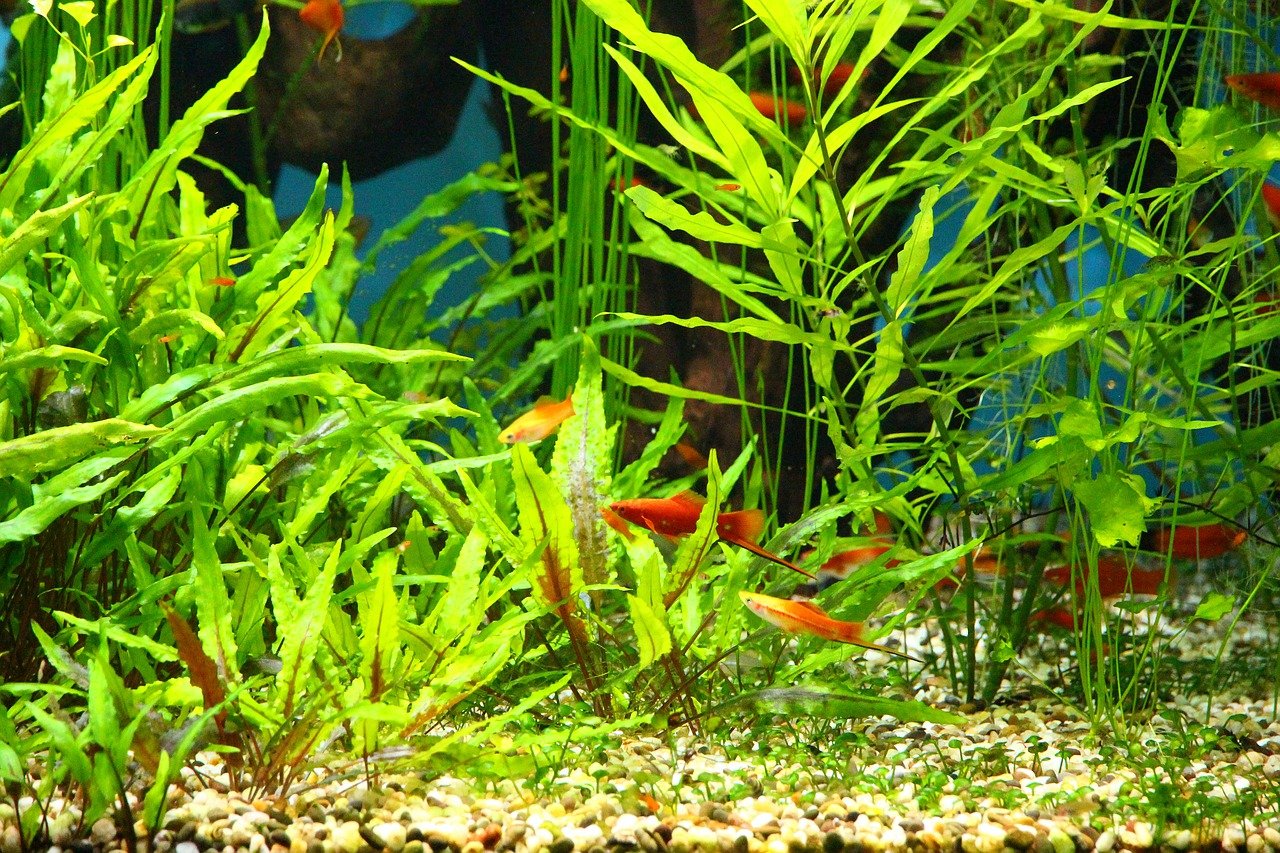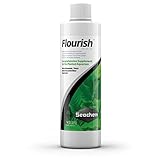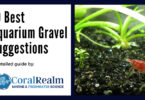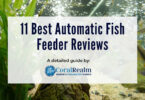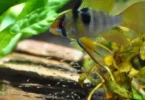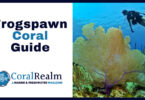Last Updated on February 10, 2023 by Matt
Having a planted freshwater tank has huge benefits to both you and your fish. Therefore keeping your plants healthy is just as important as keeping your fish healthy! Indeed healthy plants often mean healthy fish as well. Using an aquarium plant fertilizer will help to give your plants the nutrients they need to thrive.
There are different types of aquarium plant fertilizer available; liquid plant fertilizers which are dropped straight into the water column, solid root tabs which are placed in the substrate, and pre-fertilized substrates. Liquid fertilizers are best for floating aquarium plants, while solid and substrate fertilizers are used for rooted plants.
Of the three, liquid and solid fertilizers are the easiest and simplest options. Substrates containing nutrients can have a hidden workload.
In this article we will tell you some general information about aquarium plant fertilizer and what they contain, and why you need to use them, so you have the information you need to choose the best one for you. We will then run through a combination of the best liquid, solid, and substrate fertilizers, before going over some of the most frequently asked questions.
IN THIS ARTICLE
How to Choose the Best Aquarium Plant Fertilizer
When choosing the best aquarium plant fertilizer for your tank you really only need to check a couple of things. Firstly is checking what type of aquarium plants you have. Next is checking what nutrients the fertilizer contains to see if it is suitable for the plants you are keeping.
See what type of plants you have
So first up is checking what plants you have in your aquarium. There are two main types of aquarium plants; floating plants and rooted plants. Whether a plant has true roots or not will vary what type of fertilizer it needs.
Rooted plants have true roots; that is, they are anchored into the substrate via their roots, and draw the majority of the nutrients they need from the substrate via their roots as well. Therefore solid root tabs are needed for rooted plants. Liquid fertilizer won’t do much except increase the nutrient load in the water column! This can cause unwanted algal growth. Solid root tabs release nutrients into the substrate which can be taken up by the root system. Also consider using a specific plant substrate; this is a substrate which contains all the nutrients your rooted plant will need.
Floating aquarium plants however don’t possess roots. Many of these plants instead have rhizomes which can anchor them to an attachment point. Mosses such as Java Moss also have these rhizomes. Rhizomes, unlike roots, don’t act as the primary method of nutrient uptake for the plant. Instead they draw the nutrients they need straight from the water column. As such using root tabs to fertilize these plants is wasted effort. Liquid aquarium plant fertilizer should instead be used.
What nutrients does the fertilizer contain
There are two different types of nutrients that plants need to be healthy, and that plant fertilizers will contain; macronutrients and micronutrients. Without these nutrients the plant will be deficient in that nutrient and will show signs of being unhealthy.
Macronutrients
Macronutrients are essential for growth and the overall health of the plant. The primary macronutrients are Nitrogen (N), Phosphorus (P), and Potassium (K). This is why many macronutrient fertilizers are called NPK fertilizers. Secondary macronutrients are consumed in smaller quantities than primary macronutrients but are no less essential. These are Calcium, Magnesium, and Sulfur.
Nitrogen is essential for plant development and is fundamental in chlorophyll formation and photosynthesis. Plants get nitrogen from nitrate (NO3–) and ammonium (NH₄+). Ammonium is formed through an equilibrium when ammonia is in water. Nitrogen deficiency causes a loss of color and lack of vigor in the plant, as well as glowing growth.
Phosphorus is not only involved in root growth, but is also involved in transporting and storing energy. It is also essential in organic compound formation and photosynthesis. Phosphorus deficiency causes browning and wilting leaves and lack of vigor. Plants use phosphate (PO₄³⁻) as a source of phosphorus.
Potassium strengthens cell tissue, aids in water transport and nitrate uptake, and increases a plants ability to withstand changes in weather conditions. A lack of phosphorus causes dark spots to begin to appear on the leaves. Plants use potash, potassium oxide, (K2O) as a source of potassium.
Calcium is used in the formation and stabilization of cell walls, as well as general cell growth. It is found in the water column as well as the substrate, and is measured as part of general hardness along with magnesium. Calcium deficiency stunts growth and causes brown and yellow spots to form.
Magnesium is found at the center of the chlorophyll molecule and thus is essential for photosynthesis. It also promotes uptake and transportation of phosphorus amongst many other uses. Magnesium deficiency causes the central stalk to weaken greatly and loss of green color, predominantly in older leaves. Yellow and brown spots will form on the leaves, but leaf veins will remain green.
Sulfur is used in the formation of chlorophyll and is needed for photosynthesis. It also aids in tissue formation. A sulfur deficiency causes the plant to become a much paler green as less chlorophyll is present.
Micronutrients
There are ten essential plant nutrient elements which are described as micronutrients. These are nutrients which are found in much smaller quantities in plants but are no less vital; in total micronutrients make up less than 1% of the dry weight of the average plant.
The ten micronutrients are boron, zinc, manganese, iron, copper, molybdenum, chlorine, sodium, cobalt, and silicon. These nutrients have functions ranging from use in photosynthesis, growth, energy generation and storage, and enzyme workings. Without these nutrients plants will show signs of deficiency.
Why You Should Use Aquarium Plant Fertilizer
Aquarium plants need feeding just as much as your fish do. Tap water contains some nutrients which plants can use but you shouldn’t rely on this to sustain your plants. The nutrient content of tap water varies wildly from area to area, so you need to feed them with an aquarium plant fertilizer to give them the nutrients they need.
If you use distilled water or RODI water then it is essential to give aquarium fertilizer as this water won’t have any nutrient content at all. Whilst having an RODI water system for water changes, or using distilled water, is more common for reef tanks, some freshwater tank owners do use these options.
Tap water contains chemicals such as chlorine and heavy metals which are very dangerous to fish and plants. This is why you need to treat tap water with water conditioners to make it safe for aquarium use. Water conditioners may tie up some of the nutrients as well, making them unavailable for plant use. Water changes are essential for the health of fish tanks. They can be made quicker using a product like the Python water changer.
Using an aquarium plant fertilizer is the only sure way to guarantee that your plants get all the nutrients they need. Remember that it isn’t just the main macronutrients they require to remain healthy, it is all the micronutrients as well.
Best Aquarium Plant Fertilizer Reviews

In this section we will review the best aquarium plant fertilizers on the market today. We have broken them down into three categories; liquid, solid root tabs, and aquarium plant substrate. Hopefully this makes it easier to find which one you need!
Liquid Aquarium Fertilizers
As we have said previously, liquid aquarium plant fertilizer is good for plants which draw the majority of the nutrients they need directly through their leaves. These plants are called column-feeders. They draw nutrients from the water column!
Examples of such plants are mosses like Java Moss, and other plants such as Water Wisteria and Red Root Floater. Java Moss is a perfect Betta fish plant!
1) NilocG Aquatics Thrive All In One Liquid Fertilizer
- SPOIL YOUR PLANTS WITH NUTRIENTS: Make your planted aquarium look great and provide your plants with all the essential...
- TREAT 2500 GALLONS OF WATER WITH EASE: The Thrive highly-concentrated liquid fertilizer for aquarium plants will allow...
- KEEP YOUR AQUATIC PLANTS HEALTHY: Ideal for both low and high-tech setups, our water plant fertilizer will not only keep...
- SUPER-CONVENIENT PUMP BOTTLE: Take all the fuss out of dosing and adding fertilizer to your planted tank with the Thrive...
Will will see NilocG Aquatics as a recurring theme in this article on best aquarium plant fertilizer. There is a reason for this; they have some of the very best on the market!
The NilocG Aquatics Thrive All In One Liquid Fertilizer is a brilliant liquid fertilizer which is based on the known and effective EI dosing method of fertilizing aquatic plants. Therefore both macronutrients and essential micronutrients are found.
Thrive fertilizer is an easy dosing formula of concentrated ingredients which is extremely easy to use. NilocG Aquatics Thrive is designed for use in the average aquarium, and with both low and high tech setups in mind. The ingredients include nitrogen, phosphorus, magnesium, calcium, sulfur, boron, copper, iron, manganese, molybdenum, and zinc.
There are also other versions of Thrive available if you have a specific tank setup. There is Thrive+, which is an all in one fertilizer specifically designed for high tech, low pH aquarium setups. Low pH meaning under 7. In Thrive+ nitrogen is found in two forms, nitrate and organic nitrogen. Iron is also found in higher concentration amongst others.
For low tech tanks you should use ThriveC which has three times the amount of bio-available carbon, found in non-glut forms. There is also less nitrate and phosphate to lower the chance of algal bloom.
The last in the NilocG Aquatics Thrive line is the ThriveS, designed for shrimp specific use. The concentrations of nutrients found in ThriveS are designed to be non-toxic to even sensitive shrimp. Namely, copper has been left out. Shrimp can be very sensitive to elevated levels of copper, so this formula ensure their health.
2) Seachem Flourish Growth Supplement
- SUPPLEMENT: Seachem Flourish is a comprehensive plant supplement for the natural freshwater aquarium, containing a rich...
- ELEMENTS: In order to benefit your aquatic plants and help your freshwater environment thrive, Seachem Flourish contains...
- WATER TREATMENT: For best results, use 1 capful (5 mL) of Flourish for each 250 L (60 US gallons) once or twice a week....
- SOLUTION COLOR: It is normal for the color of Seachem’s Flourish to vary by batch as the solution color is dependent...
Seachem are a very well-known brand; they produce a wide range of aquarium products which are all high quality. It is no different for the Seachem Flourish Growth Supplement range.
The start of the range is Seachem Flourish itself. It is a comprehensive aquarium plant fertilizer which contains a range of micronutrients and other elements to promote and aid plant health and growth.
The ingredients include a comprehensive list of micronutrients; nitrogen, phosphorus, potassium, calcium, magnesium, sulfur, boron, chlorine, cobalt, copper, iron, manganese, molybdenum, sodium, and zinc. It doesn’t contain that much nitrogen, phosphorus, or potassium, which is why it should be used in conjunction with other macronutrient NPK fertilizers.
This is where the other products of the Seachem Flourish series come in. With the Seachem Flourish Nitrogen, Seachem Flourish Phosphorus, and Seachem Flourish Potassium, you can add as much or as little of these essential macronutrients as you like.
This gives you more control over the concentrations of both macro and micronutrients, meaning you won’t be overdosing on any.
There is also the Seachem Flourish Advance, which contains phytohormones, minerals, and nutrients which are proven to dramatically stimulate the growth of both roots, shoots, and leaves in aquarium plants. Phytohormones are signal molecules which are crucial in every stage of the developmental process.
There is one more product in the Flourish series; the Seachem Flourish Excel. Excel is a source of bioavailable organic carbon aquarium plants. It can be used both in addition to a CO2 injection through an aquarium CO2 regulator or as an alternative. It also introduces photosynthetic intermediates into the aquarium to further promote growth.
3) NilocG Aquatics Liquid NPK + M Aquarium Plant Fertilizer for Demanding Planted Tanks
- 2x 500ml Pump Bottles(One micro and one macro bottle)
- Very Concentrated
- This product is tailored to the EI dosing method but can be adapted to other dosing techniques
- Treats 2500 Gallons
NilocG Aquatics again find themselves on this list with their Liquid NPK + M Aquarium Plant Fertilizer.
This product is designed for use in demanding planted tanks. Though it can also be used in lower tech tanks with a lowered dose. Demanding tanks are heavily planted and/or have a combination of heavy root-feeders and column-feeders. These tanks need regular fertilization or the plants will quickly become deficient in both macronutrients and micronutrients.
The Liquid NPK + M Aquarium Plant Fertilizer is designed for use with the EI dosing method. This method is fairly complicated, so should only be used by experienced aquarists with tanks that really need this higher level of fertilization. One of the bottles contains the macronutrients which aquatic plants need for growth; the NPK side of fertilization. The other bottle contains micronutrients, which is the M in the title.
Recommended usage is as follows; 1 pump of each bottle per 10 gallons three times per week on alternate days. For less demanding lower light/lower tech tanks the dose is recommended at 1 pump per 20 gallons three times per week on alternate days. At the end of the week a 50% water change is needed followed by a dose of GH (general hardness) booster. A GH booster adds calcium and magnesium into the tank.
So for a 20 gallon higher lighting tank, the dose would be 2 pumps of the micros per day on each of Monday, Wednesday, and Friday, and 2 pumps of the macros per day Tuesday, Thursday, and Saturday. This is then followed by a 50% water change on Sunday, after which a dose of GH booster is added.
This method is proven to work wonders for growth and health of aquarium plants, as it provides all the essential nutrients and minerals they need to thrive.
4) Fluval Hagen Grow Plus Plant Micronutrient for Aquariums
- All in one micro-nutrient, iron enriched formula promotes vigorous growth, deep colors and a strong root system
- Prevents mineral deficiencies and promotes disease resistance
- Enriched with iron and fortified with an effective source of Vitamin B that is safe for fish and all aquarium inhabitants
- Use weekly as plants will deplete micro-nutrients naturally over time, and because regular tap water often lacks these elements
- 8.4-ounce bottle for use in freshwater aquariums only
Fluval Hagen Grow Plus is a concentrated, complete micronutrient liquid aquarium plant fertilizer. It has an iron-enriched formula which promotes vigorous growth, natural deep colors, and a strong root system.
The nutrients it contains also help to prevent disease and increase disease resistance, and prevent nutrient deficiency.
Fluval Hagen Grow Plus should be used weekly. Plants will draw in nutrients, and so deplete micronutrients naturally over time, and tap water often lacks these elements. Weekly use of this product will ensure your plants have the nutrients they require. As it doesn’t contain macronutrients, if you have low concentrations of nitrate, phosphate, or potassium, then you should use a specific macronutrient fertilizer.
For best results, use Grow Plus in conjunction with Iron Test Kit to maintain a concentration of 0.3 mg/L of iron for maximal growth and health.
5) API Leaf Zone
- Aquarium plant food
- Promotes healthy aquarium plants
- For freshwater tanks
- Item Package weight : 1.25 pounds
API Leaf Zone contains a combination of iron and potassium in the form of soluble chelated iron and potash. This combination of essential nutrients promotes lush aquarium plant growth, while encouraging vibrant natural coloration.
API Leaf Zone is designed to be readily absorbed through the leaves of aquatic plants. This enables it to be available for column-feeding plants, but it is also readily available for root-feeders as well.
The contained iron promotes growth and prevents yellow, decaying leaves. Yellowing leaves can be very unsightly in any tank. Potassium aids in photosynthesis and cell pressure maintenance to provide plants with strong, hardy and colorful leaves.
The downside with API Leaf Zone is that it only contains two essential nutrients. For complete fertilization you will need to also use a specific nitrogen or phosphorus fertilizer, or micronutrient fertilizer. API have said that Leaf Zone is best used in conjunction with API Root Tabs.
API also offers a CO2 booster. The API Co2 Booster Freshwater Aquarium Plant Treatment 8 Fl oz Bottle offers two different sources of carbon to promote and maximize photosynthesis. It also won’t impact pH levels in the tank.
6) Aqueon Aquarium Plant Food
- Source of nutrients for freshwater plants
- Contains kelp extract to encourage strong root development
- Well rounded, multi-system plant supplement
- The macro and micro nutrients aid with plant growth
- Remember that healthy plants also require proper lighting!
Aqueon Aquarium Plant Food is an aquarium plant fertilizer which contains both macronutrients and micronutrients which are essential for healthy plant growth.
The product contains potassium, calcium, magnesium, sulfur, boron, iron, manganese, molybdenum, and zinc. If your aquarium needs a boost of nitrogen or phosphorus you should use specific nitrate or phosphate fertilizer to boost these compounds.
Aqueon Aquarium Plant Food also contains kelp extract to encourage root development. The nutrient load which it contains aids plants in disease defence, as well as promoting proper functioning photosynthesis, and will get plants looking fuller, greener, and more luscious.
Solid Root Tab Aquarium Plant Fertilizers
Solid aquarium plant fertilizer are often also known as root tabs. These fertilizers come in the form of solid capsules which are placed directly into the substrate. Here they release the nutrients they contain which are then available to be absorbed by the root system of your rooted aquatic plants.
These plants are called root-feeders, as they get the majority of their nutrients through their roots. Examples of root-feeders are Cryptocorynes and Amazon Sword.
7) Seachem Flourish Tabs Growth Supplement
- GROWTH TREATMENT: Seachem Flourish Tabs are growth stimulating tablets for plant roots which contain essential trace...
- VITAMINS: Seachem Flourish Tabs are rich in iron, manganese, magnesium, calcium, potassium, inositol, choline B12,...
- NUTRIENTS: When inserted into the gravel, Seachem Flourish Tabs provide direct, time-released fertilization to the...
- TANK USE: Insert one Flourish Tab in the gravel for every 10–15 cm (4–6 in.) radius. A standard 10 gallon aquarium...
Seachem Flourish Tabs Growth Supplement are a complete root tab aquarium plant fertilizer.
They contain a long list of ingredients which will provide your aquatic plants with all the nutrients they could possibly need. The ingredients include nitrogen, phosphorus, potassium, calcium, magnesium, sulfur, boron, cobalt, copper, iron, manganese, molybdenum, and zinc.
As you can see Seachem Flourish Tabs will provide your plants with an array of macronutrients as well as micronutrients. These nutrients are slowly released via enzymatic action to allow for slow continuous uptake by the root system.
These root tabs shouldn’t affect pH but if you have very soft water with a low carbonate hardness they could have slight acidic properties. Carbonate hardness acts as an acidity buffer.
One tab should be inserted for every 4 to 6 inch radius. A standard 10 gallon tank would require 6 tabs to give you a bit of reference. The tabs need to be inserted about halfway into the substrate bed, and need replacing every 3 to 4 months.
8) NilocG Aquatics ThriveCaps Aquarium Root Tabs
- ThriveCaps are nutrient rich tablets which are intended to be placed in the substrate of a planted freshwater aquarium. They will provide a long lasting nutrient source essential for healthy plant growth.
- ThriveCaps are the only commercially available aquarium specific root tabs that contain all the necessary micro and macro nutrients so your plants can THRIVE
- Other competitor tabs claim the fact that they lack certain nutrients(Flourish tabs dont contain nitrogen or phosphate) is a good thing. This just isnt true. They are necessary for the survival of the plants.
- 60 Count Caps | 1 grams Per cap
- ThriveCaps are a blend of dry Thrive mix, iron rich clay and mineralized top soil.
Similarly to those by Seachem, the NilocG Aquatics ThriveCaps Aquarium Root Tabs contains a comprehensive list of ingredients which includes both macronutrients and essential micronutrients. This blend of minerals are designed to be released slowly to ensure that your plants have a continuous supply of essential nutrients directly to their roots.
The nutrients provided are nitrogen, phosphorus, potassium, magnesium, sulfur, boron, cobalt, copper, iron, manganese, molybdenum, zinc, and nickel.
With a new improved formula, the water clouding effect of using solid fertilizers is greatly reduced.
NilocG Aquatics ThriveCaps should be placed at the base of each plant or spaced every six inches in a grid pattern throughout the substrate. The capsules should be pushed down to the bottom of the substrate. They need to be replaced every 3-4 months.
9) API Root Tabs Aquarium Plant Fertilizer
- Contains Three API root tabs freshwater aquarium Plant fertilizer 0.4-Ounce 10-Count box
- Promotes strong root development for lush plants in freshwater aquariums
- Contains essential nutrients including iron, Potassium and carbon
- Helps new aquatic plants get off to a vigorous start and to keep established plants flourishing
- Pack of 3
API Root Tabs promote lush growth of aquarium plants, and have ingredients which promote healthy root growth.
The ingredients include iron, potassium, and carbon. These are essential nutrients for plants, and especially root-feeders. However there are a lot of macro- and micronutrients not in this ingredient list. So these root tabs are not a complete aquarium plant fertilizer. But when used in conjunction with a liquid fertilizer can provide complete nutritional content.
API root tabs are useful for planted tanks with a high bioload. A high bioload tank normally has a high nitrate and carbon content anyway, so the limiting factors for these tanks is often iron and potassium. So API root tabs can be very useful. In tanks which need more comprehensive fertilization though Seachem Flourish tabs are probably a better option.
One API root tab covers 30 square inches of substrate. A standard 10 gallon tank will need 6 tabs to give you perspective. They need to be placed halfway into the substrate bed, and will need replacing monthly.
10) Planted Aquarium Concepts Aquarium Plant Root Fertilizer
- 40 count, slow release root fertilizer tablets
- Use in gravel bed or aquatic substrate to supply live aquarium plants with vital nutrients.
- Balanced blend of slow release fertilizers to supply aquatic plants with nutrients when and where they need it.
- Contains (N, P, K, Fe, Mg, Mn, Zn, Mo, B, Co, Ni) See description for analysis
- Store at room temperature with bag sealed.
Planted Aquarium Concepts Fertilizer Tabs are designed with a balanced blend of slow release fertilizers to supply aquarium plants with the correct amount of nutrients they need directly to their root system.
The nutrient list is substantial, with all the macronutrients and micronutrients that root-feeders need to be fully heavy. The tabs include nitrogen, phosphorus, potassium, calcium, magnesium, sulfur, boron, cobalt, iron, manganese, molybdenum, zinc, and nickel.
Tabs should be pressed into the substrate near the base of any rooted plants. Otherwise they should be spaced around 3-6 inches apart. Tabs only need replacing every 3 months. Press each tab deep into the substrate. For best results the substrate should be at least 1-2 inches deep. You can increase or decrease spacing between tabs depending on how densely planted your tank is.
Using these aquarium plant fertilizer tabs will allow you plants to grow healthy and vibrant, and maintain a healthy root system.
Aquarium Plant Fertilizer FAQs

In this section we will run through some of the most frequently asked questions regarding aquarium plant fertilizers. Hopefully if you are still wondering about anything after reading the article your questions will be answered here. If not please let us know in the comments and we will try our best to answer!
How do I use aquarium fertilizers?
Each aquarium plant fertilizer will have its own dosage instructions provided by the manufacturer. These may be very similar or very different depending on the product.
For example root tabs usually have similar instructions, but some liquid fertilizers have very different dosage instructions.
Always make sure that you read the manufacturers guidelines carefully so you don’t overdose.
Are aquarium plant fertilizers safe for fish?
Using an aquarium plant fertilizer is completely safe for fish. They are also mostly safe for shrimp, snails, or any other animal you might be keeping in the tank. They are designed for aquarium use and so won’t contain any compounds or nutrients which will have an adverse effect on the health of your fish. Some shrimp species are very sensitive to copper, so if you are worried about a shrimp colony then you should use a shrimp-safe fertilizer such as NilogG Aquatics ThriveS.
Don’t overdose your aquarium with fertilizer though, as the secondary effects of doing this could harm your fish. Namely we are talking about unwanted algal growth. Remember that algae are just microscopic plants. They will happily use the nutrients in aquarium fertilizers the same as your plants will. If you use the recommended dose, your plants will use the nutrients before algae has time to explode in number. However if you overdose, even after the plants have had their fill there will be a lot of nutrients left over. Algae will quickly utilize this excess and bloom.
Some algae release harmful chemicals into the water which will cause damage to your fish, but the real problems will start once the algae begins to die. The huge amount of excess decaying organic material will cause huge spikes in ammonia and nitrite. These nitrogenous compounds are very dangerous, and will cause ammonia poisoning and nitrite poisoning. Normally the action of the biological filter will remove these, but the amount produced by the decaying algae will overwhelm the capacity of the filter.
Are fertilizers necessary?
In short, yes. To keep your plants fully healthy it is necessary to use an aquarium plant fertilizer. While hardy plants will maybe do ok without regular fertilization, eventually even they will start to wilt and brown.
In order to keep aquarium plants green and flourishing then yes, using a fertilizer regularly is essential. Keep those plants fed!
Conclusion
Hopefully now you have gained all the information you need on aquarium plant fertilizers! You should now know whether you need liquid or solid tab fertilizer for your plants. You should also know the difference between macronutrients and micronutrients, and so should be able to tell if a specific fertilizer is appropriate for your tank.
Many fertilizers contain a mixture of both macro- and micronutrients, while some contain only a few specific nutrients.
The choice for the best aquarium plant fertilizer is completely dependent on your specific planted tank setup. However the NilocG Aquatics Thrive All In One Liquid Fertilizer and Seachem Flourish Tabs Growth Supplement are brilliant options which will enable your plants to have all the nutrients they need.

